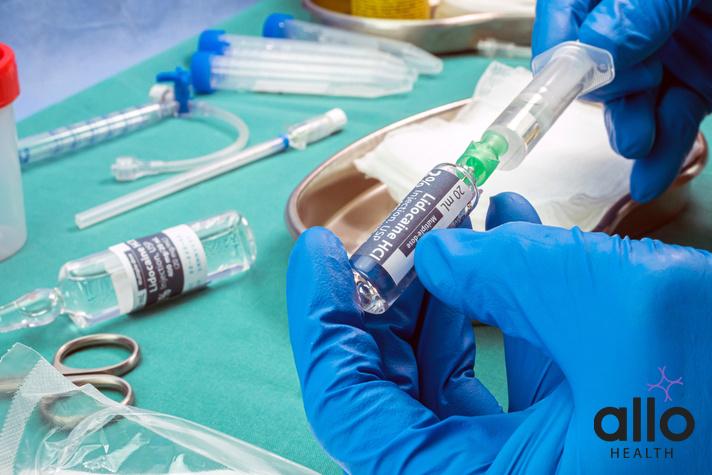HPV Discharge: Symptoms, Risks, and Prevention

Allo Health is dedicated to personalized well-being, offering support and trusted information tailored to individual health goals. The platform emphasizes human-generated content, led by a distinguished medical team of experts, including physicians and sexual health specialists. Their commitment to credibility involves rigorous fact-checking, authoritative research, and continuous updates to ensure accurate, up-to-date information. Allo Health's unique approach goes beyond conventional platforms, providing expert-led insights and a continuous commitment to excellence, with user feedback playing a crucial role in shaping the platform's authoritative voice.

Dr Sanina Mansoor holds MBBS degree from Yenepoya university,Mangalore.She has 8 years of experience working as a medical officer at various health centres and medical colleges.
Why This Was Upated?
Our experts continually monitor the health and wellness space, and we update our articles when new information became available.
Updated on 08 April, 2024
- Article was updated as part of our commitment to diversity, equity, and inclusion.

"The following blog article provides general information and insights on various topics. However, it is important to note that the information presented is not intended as professional advice in any specific field or area. The content of this blog is for general educational and informational purposes only.
Book consultation
The content should not be interpreted as endorsement, recommendation, or guarantee of any product, service, or information mentioned. Readers are solely responsible for the decisions and actions they take based on the information provided in this blog. It is essential to exercise individual judgment, critical thinking, and personal responsibility when applying or implementing any information or suggestions discussed in the blog."
Human papillomavirus (HPV) is a common sexually transmitted infection that affects millions of people worldwide. One of the common and noticeable symptoms of HPV is abnormal discharge. In this article, we will explore the various aspects of HPV discharge, its connection to genital warts, cervical cancers, and other health complications, as well as prevention and treatment options.
What is HPV?
- HPV, or human papillomavirus, is a group of sexually transmitted viruses that infect the genital area, mouth, and throat through intimate contact with an infected person.
- It encompasses various types, including high-risk and low-risk HPV types, with some causing genital warts, a common symptom characterized by discolored bumps or flat lesions. HPV is a leading cause of cervical cancer in women, linked to certain high-risk HPV infections and noticeable through routine Pap tests, which detect abnormal cervical tissue. Additionally, HPV can result in anal cancer, oropharyngeal cancers, and penile cancer in men, underscoring its connection to various cancer types.
- Recognizable symptoms include foul-smelling or odorous vaginal discharge, blood-streaked discharge, and an increase in discharge between menstrual periods.
- Preventative measures include FDA-approved HPV vaccines for both sexes, safe sexual practices, and regular screening for HPV-related conditions. Seeking prompt healthcare attention is crucial if one notices abnormal discharge or visible warts, as timely intervention can prevent long-term health complications associated with HPV infections.
Complications Due to HPV
Human papillomavirus (HPV) is responsible for several diseases, including:
- Genital Warts: HPV infection can lead to the development of visible warts in the genital and anal areas. These warts are caused by certain HPV types and can be diagnosed through a physical exam by a healthcare professional.
- Cervical Cancer: HPV is a leading cause of cervical cancer in women, primarily linked to high-risk HPV infections. Routine screening with Pap tests is crucial for the early detection of abnormal cervical tissue, which can be precancerous or cancerous.
- Anal Cancer: HPV-related anal cancer is more common in individuals engaged in receptive anal intercourse and is caused by specific HPV types. Regular screening and monitoring are essential for early detection.
- Oropharyngeal Cancers: HPV can infect the mouth and throat through oral intercourse, leading to cancers in the oropharyngeal area. These cancers can be detected through physical exams and biopsies.
- Penile Cancer: Men can also develop penile cancer due to HPV infection, particularly if they are exposed to high-risk HPV types. Early diagnosis through physical examination is vital.
- HPV-Related Anal Cancer: Anal cancer linked to HPV infection can result in severe health complications if left untreated. Routine screening and healthcare provider consultation are necessary for timely intervention.
- HPV-Related Conditions: HPV infection can cause various genital conditions, including abnormal discharge, visible warts, and discolored bumps, all of which require medical attention.
Understanding the potential health risks associated with HPV is essential for timely prevention, screening, and treatment, emphasizing the importance of vaccination, safe sexual practices, and regular check-ups with healthcare professionals.
What is HPV Discharge?
- HPV discharge, also known as abnormal discharge, is a symptom associated with human papillomavirus (HPV) infections. This discharge can manifest in various forms, including foul-smelling, odorous, and blood-streaked vaginal discharge. An increase in discharge, especially between menstrual periods, can also be noticeable.
- HPV is a common sexually transmitted infection transmitted through sexual contact, including oral and anal intercourse, making it a significant concern for sexually active individuals. High-risk HPV infections are linked to cervical cancer in women, anal cancer, oropharyngeal cancers, and penile cancer in men.
- Regular screening through pap tests is essential for early detection and management of abnormal cells caused by HPV, reducing the risk of advanced cancers and cancer recurrence. Seeking medical attention from a healthcare provider for visible symptoms like genital warts or discolored bumps is crucial for diagnosis and treatment.
- Prevention measures include vaccination with FDA-approved HPV vaccines, practicing safe sex, and maintaining a healthy sexual history to minimize the risk of HPV-related conditions and long-term health complications.
Symptoms of HPV Discharge

Symptoms of HPV discharge can vary among individuals, and not everyone infected with HPV will experience noticeable symptoms. However, when symptoms do occur, they may include:
- Abnormal Discharge: HPV can cause an increase in vaginal discharge, often foul-smelling or odorous, which may be blood-streaked or occur between menstrual periods.
- Visible Symptoms: Some individuals may develop visible symptoms like genital warts, flat lesions, or discolored bumps in the genital or anal area, indicating an HPV infection.
- Risk Types: The type of HPV involved can influence the symptoms and associated risks. High-risk HPV infections can lead to cervical cancers, while low-risk types often result in genital warts.
- Precancerous Condition: Persistent high-risk HPV infections may lead to the development of abnormal tissue in the cervix, potentially progressing to cervical cancer, making early detection through routine Pap tests crucial.
- Genital Warts: Warts are a common symptom, appearing as visible warts or raised growths. Surgical removal is often necessary.
It’s important to note that HPV infections may not always present noticeable symptoms. Regular screening, vaccination, and consulting a healthcare professional are essential for early detection and management of HPV-related conditions.
Treatment Options

Treatment options for HPV discharge vary depending on the severity of the infection and the presence of related complications. Here are some common approaches:
- Medical Consultation: If you experience abnormal discharge, it’s crucial to consult a healthcare professional who can perform a physical exam, including a pelvic exam for women and genital examination for men. They may also take samples of the discharge for lab testing to confirm the presence of HPV or other infections.
- Prescription Medications: Healthcare providers may prescribe antiviral medications or antibiotics to manage bacterial infections, such as bacterial vaginosis or yeast infections, which can sometimes accompany HPV infections.
- Surgical Removal: Visible warts, one of the visible symptoms of HPV, can be surgically removed through procedures like cryotherapy, electrocautery, or laser therapy. This helps alleviate discomfort and reduce the risk of transmission.
- Cervical Cancer Treatment: If abnormal discharge is linked to cervical cancer, healthcare professionals will develop a treatment plan that may include surgery, chemotherapy, or radiation therapy, depending on the stage of the cancer.
- HPV Vaccination: For prevention, FDA-approved HPV vaccines are available and recommended for individuals of all genders to reduce the risk of high-risk HPV infections that can lead to cervical and other cancers.
- Follow-Up Care: Regular follow-up appointments with a healthcare provider are essential for monitoring the condition, especially if abnormal tissue or precancerous conditions are detected.
Treatment options for HPV discharge involve a combination of medical consultation, prescription medications, surgical interventions, and preventive measures such as vaccination. Early detection and prompt intervention play a crucial role in managing HPV-related symptoms and reducing the risk of long-term health complications.
Prevention and Precautions for HPV Discharge
HPV Vaccination:
- One of the most effective ways to prevent HPV-related discharge and its associated health complications is through vaccination.
- FDA-approved HPV vaccines are available and recommended for both males and females to protect against high-risk HPV types that can lead to cancer.
Safe Sexual Practices:
- Limiting the number of sexual partners and practicing safe sex, including consistent condom use during sexual intercourse, can reduce the risk of HPV transmission.
- Knowing the sexual history of your partner is important to assess potential exposure to HPV.
Routine Screening:
- Regular routine screening, such as pap tests for women and HPV tests for both genders, can help detect abnormal cells and HPV-related conditions early.
- Healthcare professionals can perform pelvic exams and other tests to identify any abnormal tissue or visible warts.
Healthcare Provider Consultation:
- If you notice any abnormal discharge or visible symptoms like genital warts, it’s crucial to consult a healthcare professional promptly.
- Seek advice on appropriate healthcare solutions, including prescription medicines and minor procedures if necessary.
Partner Communication:
- Open and honest communication with sexual partners about your sexual history and any potential HPV infections is essential to prevent transmission.
- Encourage partners to seek vaccination and healthcare solutions if needed.
Health Education:
- Stay informed about HPV-related diseases, their connection to cancer, and the importance of early detection.
- Understand the common symptoms and risk factors associated with HPV discharge.
By following these preventive measures and precautions, individuals can reduce the risk of HPV-related discharge and its potential long-term health complications. Vaccination, safe sexual practices, routine screening, and partner communication are vital steps in managing HPV-related conditions and promoting overall sexual health.
Conclusion
HPV discharge is a common symptom that can be indicative of various health conditions, including genital warts and cervical cancer. Understanding the risks, recognizing visible symptoms, and seeking timely medical attention are key in preventing and managing HPV-related diseases. Additionally, HPV vaccines are effective in reducing the risk of infection, emphasizing the importance of vaccination for both males and females. Regular check-ups and a responsible approach to sexual health can significantly reduce the impact of HPV on individuals and society.
Most Asked Questions
-
What is HPV discharge, and how can I recognize it?
HPV discharge is an abnormal fluid that can come from the genital area when someone has a human papillomavirus (HPV) infection. It might have a bad smell or even have a bit of blood. If you notice unusual changes in your discharge, like an increase or odd smell, it’s essential to consult a healthcare professional.
-
Can HPV discharge lead to serious health problems?
Yes, HPV discharge can be a sign of more severe issues like cervical cancer. If left untreated, HPV can cause long-term health complications. Regular check-ups and screenings, like Pap tests, can help catch problems early and prevent them from getting worse.
-
How can I protect myself from HPV and its discharge symptoms?
Getting vaccinated against HPV is one of the most effective ways to protect yourself. Safe sexual practices, such as using condoms and limiting the number of sexual partners, can also help reduce the risk of HPV transmission. Regular check-ups with a healthcare provider are vital for early detection and prevention.
-
What should I do if I suspect I have HPV discharge or related symptoms?
If you notice any unusual discharge or visible symptoms in your genital area, it’s essential to seek medical attention promptly. A healthcare professional can diagnose and provide appropriate treatment options, ensuring your health and well-being. Don’t hesitate to reach out for help if you have concerns.






































